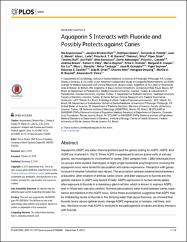Aquaporin 5 interacts with fluoride and possibly protects against caries

Göster/
Erişim
info:eu-repo/semantics/openAccessAttribution 4.0 Internationalhttps://creativecommons.org/licenses/by/4.0/Tarih
2015Yazar
Anjomshoaa, IdaBriseno-Ruiz, Jessica
Deeley, Kathleen
Poletta, Fernardo
Mereb, Juan
Leite, Aline
Barreta, Priscila
Silva, Thelma
Dizak, Piper
Ruff, Timothy
Patır, Aslı
Koruyucu, Mine
Abbasoğlu, Zerrin
Casado, Priscila
Brown, Andrew
Zaky, Samer
Bayram, Merve
Kuechler, Erika
Cooper, Margaret
Liu, Kai
Marazita, Mary
Tanboğa, İlknur
Granjeiro, Jose
Seymen, Figen
Castilla, Eduardo
Orioli, Ieda
Sfeir, Charles
Owyang, Hongjiao
Buzalaf, Marilia
Vieira, Alexandre
Üst veri
Tüm öğe kaydını gösterKünye
Anjomshoaa, I., Briseno-Ruiz, J., Deeley, K., Poletta, F., Mereb, J., Leite, A. ... Vieira, A. (2015). Aquaporin 5 interacts with fluoride and possibly protects against caries. Plos One, 10(12). https://dx.doi.org/10.1371/journal.pone.0143068Özet
Aquaporins (AQP) are water channel proteins and the genes coding for AQP2, AQP5, and AQP6 are clustered in 12q13. Since AQP5 is expressed in serous acinar cells of salivary glands, we investigated its involvement in caries. DNA samples from 1,383 individuals from six groups were studied. Genotypes of eight single nucleotide polymorphisms covering the aquaporin locus were tested for association with caries experience. Interaction with genes involved in enamel formation was tested. The association between enamel microhardness at baseline, after creation of artificial caries lesion, and after exposure to fluoride and the genetic markers in AQP5 was tested. Finally, AQP5 expression in human whole saliva, after exposure to fluoride in a mammary gland cell line, which is known to express AQP5, and in Wistar rats was also verified. Nominal associations were found between caries experience and markers in the AQP5 locus. Since these associations suggested that AQP5 may be inhibited by levels of fluoride in the drinking water that cause fluorosis, we showed that fluoride levels above optimal levels change AQP5 expression in humans, cell lines, and rats. We have shown that AQP5 is involved in the pathogenesis of caries and likely interacts with fluoride.
WoS Q Kategorisi
Q2Scopus Q Kategorisi
Q1Kaynak
Plos OneCilt
10Sayı
12Koleksiyonlar
Aşağıdaki lisans dosyası bu öğe ile ilişkilidir:


















